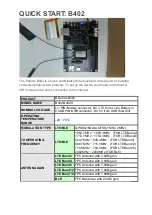
CHAPTER 15 Media
Mediant 4000 SBC | User's Manual
●
The device can forward MKI size transparently for SRTP-to-SRTP media flows or
override the MKI size during negotiation (inbound or outbound leg).
The key lifetime field is not supported. However, if it is included in the key it is ignored and the call
does not fail. For SBC calls belonging to a specific SIP entity, you can configure the device to
remove the lifetime field in the 'a=crypto' attribute (using the IP Profile parameter, IpProfile_
SBCRemoveCryptoLifetimeInSDP).
For SDES, the keys are sent in the SDP body ('a=crypto') of the SIP message and are typically
secured using SIP over TLS (SIPS). The encryption of the keys is in plain text in the SDP. The
device supports the following session parameters:
■
UNENCRYPTED_SRTP
■
UNENCRYPTED_SRTCP
■
UNAUTHENTICATED_SRTP
Session parameters should be the same for the local and remote sides. When the device is the
offering side, the session parameters are configured by the following parameters - 'Authentication
on Transmitted RTP Packets', 'Encryption on Transmitted RTP Packets, and 'Encryption on
Transmitted RTCP Packets'. When the device is the answering side, the device adjusts these
parameters according to the remote offering. Unsupported session parameters are ignored, and do
not cause a call failure.
Below is an example of crypto attributes usage:
a=crypto:1 AES_CM_128_HMAC_SHA1_80 inline:PsKb5X0YLuSvNrImEh/dAe
a=crypto:2 AES_CM_128_HMAC_SHA1_32
inline:IsPtLc6XVzRuMqHlDnEiAd
The device also supports symmetric MKI negotiation, whereby it can forward the MKI size received
in the SDP offer 'a=crypto' line in the SDP answer. You can enable symmetric MKI globally (using
the EnableSymmetricMKI parameter) or per SIP entity (using the IP Profile parameter, IpProfile_
EnableSymmetricMKI and for SBC calls, IpProfile_SBCEnforceMKISize). For more information on
symmetric MKI, see
You can configure the enforcement policy of SRTP, using the EnableMediaSecurity parameter and
IpProfile_SBCMediaSecurityBehaviour parameter for SBC calls. For example, if negotiation of the
cipher suite fails or if incoming calls exclude encryption information, the device can be configured to
reject the calls.
You can also enable the device to validate the authentication of packets for SRTP tunneling for
RTP and RTCP. This applies only to SRTP-to-SRTP SBC calls and where the endpoints use the
same key. This is configured using the 'SRTP Tunneling Authentication for RTP' and 'SRTP
Tunneling Authentication for RTCP' parameters.
●
For a detailed description of the SRTP parameters, see
and
.
●
When SRTP is used, channel capacity may be reduced.
The procedure below describes how to configure SRTP through the Web interface.
➢
To enable and configure SRTP:
1.
Open the Media Security page (
Setup
menu >
Signaling & Media
tab >
Media
folder >
Media
Security
).
- 181 -
Summary of Contents for Mediant 4000 SBC
Page 1: ...User s Manual AudioCodes Series of Session Border Controllers SBC Mediant 4000 SBC Version 7 2...
Page 40: ...Part I Getting Started with Initial Connectivity...
Page 48: ...Part II Management Tools...
Page 113: ...Part III General System Settings...
Page 118: ...Part IV General VoIP Configuration...
Page 525: ...Part V Session Border Controller Application...
Page 654: ...Part VI Cloud Resilience Package...
Page 663: ...Part VII High Availability System...
Page 685: ...Part VIII Maintenance...
Page 759: ...Part IX Status Performance Monitoring and Reporting...
Page 844: ...Part X Diagnostics...
Page 888: ...Part XI Appendix...
















































